Student Learning Outcomes
National Park College collects student learning outcomes data, or key measures of student learning, based on specific general education objectives each year. Information collected through general education assessment, Business Division assessment, and individual course assessment is used to analyze student learning to improve course curriculum, degree requirements, and program viability.
| Performance Indicator | Definition |
|---|---|
| 1. Student Learning Results |
A student learning outcome is one that measures a specific competency attainment. Examples of a direct assessment (evidence) of student learning attainment that might be used include: capstone performance, third-party examination, faculty-designed examination, professional performance, licensure examination). Add these to the description of the measurement instrument in column two:
- If for any given performance measure your goal is being exceeded repeatedly, consider either increasing the goal or changing the performance measure so that action can be taken to improve the program. - For all data reported, show sample size (n=75). |
| Performance Measure: For each assessment, identify the following - 1. Academic Program, 2. Student Learning Outcome, 3. Measurable Goal | What is your measurement instrument or process? Do not use grades. Indicate type of instrument (e.g. direct, formative, internal, comparative) | Current Results: What are your current results? | Analysis of Results: What did you learn from your results? | Action Taken or Improvement Made: What did you improve or what is your next step? | Provide a graph or table of resulting trends (3-5 data points preferred) |
|---|---|---|---|---|---|
| Program - AAS in Business Management - Accounting; PLO 1- "Perform tasks following acceptable guidelines and processes for the specific discipline"; Goal - 80% score on Milestone 3 | In ACT-1113 (Principles of Accounting II), students scores on Milestone 3 on the final project will assess ability to journalize transactions for bonds payable and interest expense using the effective interest amortization method. This is a direct, summative, internal assessment. | Students are consistently exceeding the benchmark of 80 percent set by the college. | Changes were made in prior semesters to improve mastery of this PLO. Handwritten homework was required beginning Fall 2019. Data suggests the change resulted in student mastery of this particular skill. | The benchmark will be raised to 85 percent for this PLO. | 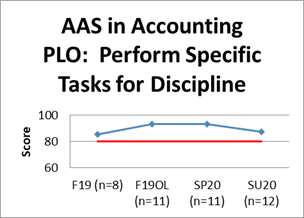 |
| Program - AAS in Business Management - Accounting; PLO 2, "Use appropriate technology
proficiently". Goal - 70% or higher score on the Excel 5-8 Capstone Exam |
In CIS-1013, Information Systems, students scores on the capstone exam will show comprehension of Excel skills and ability to use the skills learned in Excel Modules 5-8. This is a direct, summative, external, and comparative assessment. | Of the students who submitted the capstone exam, at least 50% each semester scored a 70% or higher on the capstone exam in both the traditional and online classes even with the transition of classes going totally virtual and online in Spring 2020. | Even though the students are meeting the goal, they continue to struggle when creating the more complex formulas on the Excel 5-8 capstone exam. The two instructors who teach the course have collaborated on what is occurring with the students and ways to assist them. | The textbook and software were updated to Office 2019. The course was modified beginning in Fall 2020 to include a module textbook project grade and a training grade. As an extra assistance to students, when NPC went totally online because of the pandemic in March 2020, Ms. Brown created VidGrid videos and posted them in her course shell to assist students who are struggling with content. With the new textbook, content was rearranged in the course shell. | 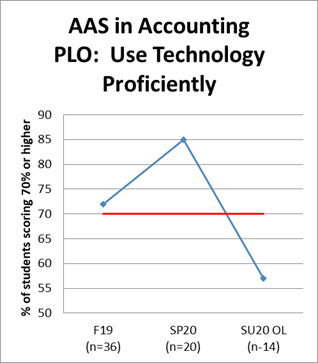 |
| Program - AAS in Business Management - Accounting; PLO 3- "Evaluate alternatives that promote effective decision making"; Goal - 80% score on Milestone 3 | In ACT-1113 (Principles of Accounting II), student scores on Milestone 7 on the final project will assess ability to make outsourcing and process further decisions - differential analysis. This is a direct, summative, internal assessment. | Students are consistently exceeding the benchmark of 80 percent set by the college. | Changes were made in prior semesters to improve mastery of this PLO. Handwritten homework was required beginning Fall 2019. Data suggests the change resulted in student mastery of this particular skill. | The benchmark will be raised to 85 percent for this PLO. | 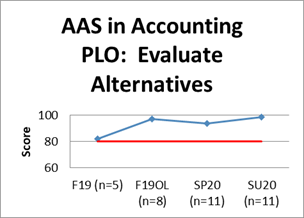 |
| Program - AAS in Business Management - Accounting; PLO 4 - "Use critical thinking and problem solving skills in business scenarios"; Goal - 80% score on Milestone 3 | In ACT-1113 (Principles of Accounting II), student scores on Milestone 4 on the final project will assess ability to prepare a statement of cash flows following the indirect method. This is a direct, summative, internal assessment. | Students are consistently exceeding the benchmark of 80 percent set by the college. | Changes were made in prior semesters to improve mastery of this PLO. Handwritten homework was required beginning Fall 2019. Data suggests the change resulted in student mastery of this particular skill. | The benchmark will be raised to 85 percent for this PLO. | 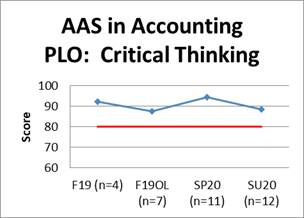 |
| Program - AAS in Business Management - Accounting PLO 5 - "The student will demonstrate
the ability to communicate effectively using oral, written, and electronic methods." Goal - 75% score on verbal presentation using verbal communications rubric outline; oral presentation is created from written career report & a PowerPoint is also created from the career report & used during verbal presentation. |
In BUS-2033 (Business Communications), student scores derived from verbal rubric outline to assess ability to deliver a verbal presentation. This is a formative, internal assessment. | After three years of student performance, the goal has been met for three years. | Students who follow the verbal rubric outline including all parts of the introduction, body, and conclusion during the verbal presentation tend to score well. | Spring 2020 verbal presentations were delivered electronically rather than in person, which worked quite well. Plans to deliver presentations electronically in Spring 2021 to determine whether or not to continue complete electronic delivery or in-person delivery. | 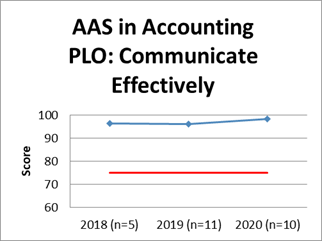 |
| Program - AAS in Business Management - Accounting; PLO 6 "Make ethical decisions in a given business situation". Goal - 70% or higher overall score on an ethical video case in Chapter 2: Business Ethics and Social Responsibility. | In BUS 1113, Intro to Business, learning to recognize ethical issues is the most important step in understanding business ethics. In this video assignment, Manager's Hot Seat: Ethics, students are assigned a video case that showcases an ethical situation in the workplace and then must respond to the questions about the video. This is a direct, formative, and external assessment. | Goal was exceeded. Of the students that completed the assignment , 100% scored 70% or higher score. | The benchmark on this assignment should be moved to 90% or higher. Even though it is a fairly simple assignment to complete, it is important for students to view the video and be able to recognize the ethical issue presented. | I think this assignment provides a valuable learning experience for the students. As an added component to this assignment, I will have students research current ethical issues in today's workplace and post an article that relates to the topic. This will further expand their exposure to the topic. Students will be required to state why they picked the article and then read each other's posts and comment on what they read. | 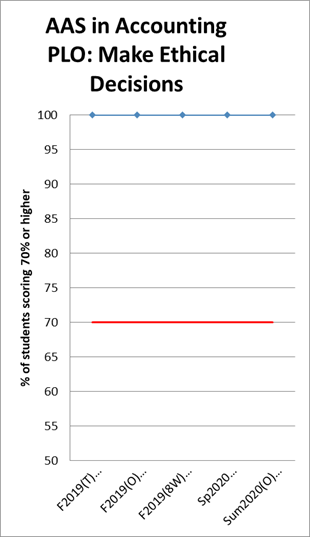 |
| Program - AAS in Business Management - Accounting PLO 7- "The student will model values
& characteristics of a business professional." Goal - 80% score on student ability to professionally present himself or herself in a mock interview, which requires professional appearance, professional verbal skills, and professional written skills through cover letter and resume preparation prior to interview as well as written follow-up docs post-interview. |
In BUS-2033 (Business Communications), student scores derived from interview rubric and/or CareerLink Mock Interview tool 5-Star rating scale to assess ability to professionally participate in a mock interview. This is a formative, internal assessment. | After three years of student performance, the goal has been met for three years. | Students who follow the interview rubric & practice their mock interview skills using the CareerLink Mock Interview practice tool tend to score well. | Spring 2020 all mock interviews were completed electronically using CareerLink rather than in person in the Career Center with Career Center scoring the interviews. Plans for all mock interviews to be electronic through CareerLink and scored via Career Center in Spring 2021. Scoring will occur on a 5-Star scale in the CareerLink program rather than using the in-person grading rubric. | 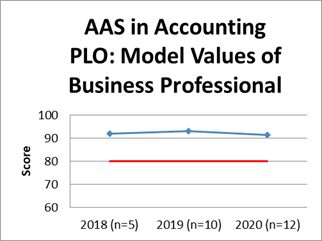 |